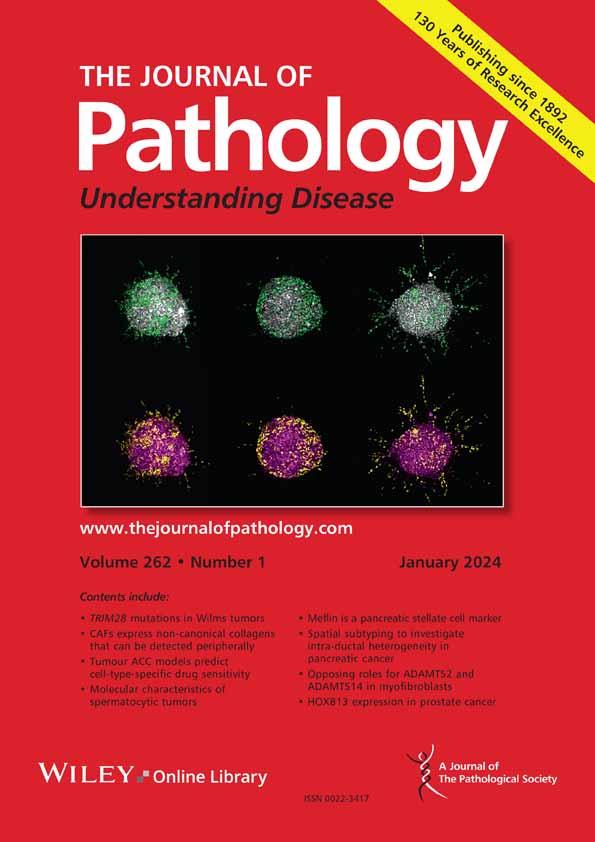Nicola S Meagher, Martin Köbel, Anthony N Karnezis, Aline Talhouk, Michael S Anglesio, Andrew Berchuck, Simon A Gayther, Paul PD Pharoah, Penelope M Webb, Susan J Ramus, Kylie L Gorringe
下载PDF
{"title":"粘液性卵巢癌的细胞起源。","authors":"Nicola S Meagher, Martin Köbel, Anthony N Karnezis, Aline Talhouk, Michael S Anglesio, Andrew Berchuck, Simon A Gayther, Paul PD Pharoah, Penelope M Webb, Susan J Ramus, Kylie L Gorringe","doi":"10.1002/path.6407","DOIUrl":null,"url":null,"abstract":"<p>Mucinous ovarian carcinoma (MOC) is a rare histotype of epithelial ovarian cancer. Its origins are obscure: while many mucinous tumours in the ovary are metastases from the gastrointestinal tract, MOC can occur as an ovarian primary; however, the cell of origin is not well established. In this review we summarise the pathological, epidemiological, and molecular evidence for the cellular origins of MOC. We propose a model for the origins of the various tumours of the ovary with mucinous differentiation. We distinguish Müllerian from gastrointestinal-type mucinous differentiation. A small proportion of the latter arise from teratoma and a distinct terminology has been proposed. Other gastrointestinal mucinous tumours are associated with Brenner tumours and arise from their associated benign lesions, Walthard nests. The remaining mucinous tumours develop either through mucinous metaplasia in established Müllerian tumours or with even greater plasticity through gastrointestinal metaplasia of epithelial or mesothelial ovarian inclusions. This model remains to be validated and mechanistically understood and we discuss future research directions. © 2025 The Author(s). <i>The Journal of Pathology</i> published by John Wiley & Sons Ltd on behalf of The Pathological Society of Great Britain and Ireland.</p>","PeriodicalId":232,"journal":{"name":"The Journal of Pathology","volume":"266 1","pages":"9-25"},"PeriodicalIF":5.2000,"publicationDate":"2025-03-03","publicationTypes":"Journal Article","fieldsOfStudy":null,"isOpenAccess":false,"openAccessPdf":"https://onlinelibrary.wiley.com/doi/epdf/10.1002/path.6407","citationCount":"0","resultStr":"{\"title\":\"Cellular origins of mucinous ovarian carcinoma\",\"authors\":\"Nicola S Meagher, Martin Köbel, Anthony N Karnezis, Aline Talhouk, Michael S Anglesio, Andrew Berchuck, Simon A Gayther, Paul PD Pharoah, Penelope M Webb, Susan J Ramus, Kylie L Gorringe\",\"doi\":\"10.1002/path.6407\",\"DOIUrl\":null,\"url\":null,\"abstract\":\"<p>Mucinous ovarian carcinoma (MOC) is a rare histotype of epithelial ovarian cancer. Its origins are obscure: while many mucinous tumours in the ovary are metastases from the gastrointestinal tract, MOC can occur as an ovarian primary; however, the cell of origin is not well established. In this review we summarise the pathological, epidemiological, and molecular evidence for the cellular origins of MOC. We propose a model for the origins of the various tumours of the ovary with mucinous differentiation. We distinguish Müllerian from gastrointestinal-type mucinous differentiation. A small proportion of the latter arise from teratoma and a distinct terminology has been proposed. Other gastrointestinal mucinous tumours are associated with Brenner tumours and arise from their associated benign lesions, Walthard nests. The remaining mucinous tumours develop either through mucinous metaplasia in established Müllerian tumours or with even greater plasticity through gastrointestinal metaplasia of epithelial or mesothelial ovarian inclusions. This model remains to be validated and mechanistically understood and we discuss future research directions. © 2025 The Author(s). <i>The Journal of Pathology</i> published by John Wiley & Sons Ltd on behalf of The Pathological Society of Great Britain and Ireland.</p>\",\"PeriodicalId\":232,\"journal\":{\"name\":\"The Journal of Pathology\",\"volume\":\"266 1\",\"pages\":\"9-25\"},\"PeriodicalIF\":5.2000,\"publicationDate\":\"2025-03-03\",\"publicationTypes\":\"Journal Article\",\"fieldsOfStudy\":null,\"isOpenAccess\":false,\"openAccessPdf\":\"https://onlinelibrary.wiley.com/doi/epdf/10.1002/path.6407\",\"citationCount\":\"0\",\"resultStr\":null,\"platform\":\"Semanticscholar\",\"paperid\":null,\"PeriodicalName\":\"The Journal of Pathology\",\"FirstCategoryId\":\"3\",\"ListUrlMain\":\"https://pathsocjournals.onlinelibrary.wiley.com/doi/10.1002/path.6407\",\"RegionNum\":2,\"RegionCategory\":\"医学\",\"ArticlePicture\":[],\"TitleCN\":null,\"AbstractTextCN\":null,\"PMCID\":null,\"EPubDate\":\"\",\"PubModel\":\"\",\"JCR\":\"Q1\",\"JCRName\":\"ONCOLOGY\",\"Score\":null,\"Total\":0}","platform":"Semanticscholar","paperid":null,"PeriodicalName":"The Journal of Pathology","FirstCategoryId":"3","ListUrlMain":"https://pathsocjournals.onlinelibrary.wiley.com/doi/10.1002/path.6407","RegionNum":2,"RegionCategory":"医学","ArticlePicture":[],"TitleCN":null,"AbstractTextCN":null,"PMCID":null,"EPubDate":"","PubModel":"","JCR":"Q1","JCRName":"ONCOLOGY","Score":null,"Total":0}
引用次数: 0
引用
批量引用






 求助内容:
求助内容: 应助结果提醒方式:
应助结果提醒方式:


